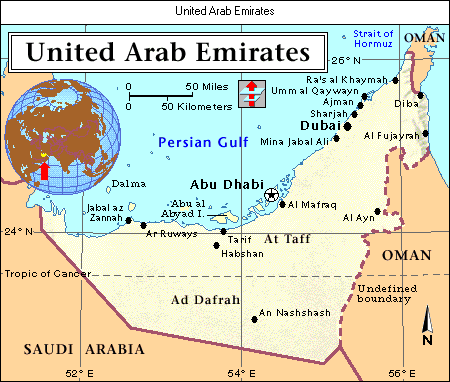|
|
|
United Arab Emirates
The United Arab Emirates (UAE)--composed of
the sheikhdoms of Abu Dhabi, Dubai, Sharjah, Ras al-Khaimah, Umm al-Qaiwain,
Ajman, and Fujairah--is located on a flat coastal plain of the Arabian
Peninsula, along the Persian Gulf. The borders with Qatar on the northwest,
Saudi Arabia on the south and west, and Oman on the east are undefined, as are
the borders between the individual sheikhdoms. Two neutral zones are shared by
several sheikhdoms.
LAND, PEOPLE, AND ECONOMY
About 80% of the UAE's area is in Abu
Dhabi. The climate is hot and dry, with mean January temperatures of 18 degrees
C (65 degrees F) and mean July temperatures of 33 degrees C (92 degrees F).
Rainfall averages 152 mm (6 in) annually. The major resource is petroleum.
Only 42% of the inhabitants are Arabs because the petroleum boom has brought in
a flood of foreign workers. About 50% of the population are South Asian. The
native population is overwhelmingly Muslim (96%). Abu Dhabi, the capital, and
Dubai are the chief cities. Six years of primary education are free and
compulsory. Health services are good because of extensive social services funded
by petroleum wealth.
Petroleum, first exported in 1962, dominates the economy of the UAE. By 1985
this once-underdeveloped region had the world's highest per capita
income--$19,120--even though its petroleum revenues later declined due to a
world oil glut. The new wealth was invested in capital improvements and social
services in all the emirates, although petroleum production is concentrated in
Abu Dhabi and Dubai. Industrial development is primarily petroleum related,
although import-substitution industries are also being developed. The desert
environment supports limited irrigated agriculture; fishing, poultry raising,
and sheepherding also provide domestic food sources. Petroleum exports have
given the UAE a large trade surplus.
HISTORY AND GOVERNMENT
At one time this area was known as the
"Pirate Coast," reflecting the major occupation of the inhabitants. To
protect its ships, Great Britain, beginning in 1820, made several treaties with
the Arab leaders outlawing sea battles. Britain handled foreign relations for
the area, then known as Trucial Oman or the Trucial States. The United Arab
Emirates gained full independence on Dec. 2, 1971, although Ras al-Khaimah did
not join until 1972. There are no elections or legal political parties;
authority rests with the seven hereditary sheikhs, who control their own domains
and choose a president from among their number. Zaid bin Sultan al-Nahayan, of
Abu Dhabi, has been president since 1971. The country abandoned its traditional
neutrality to join the U.S.-led alliance against Iraq in the 1991 Gulf War.

![]()
Facts about United Arab
Emirates
LAND
Area: 83,600 sq./km. (32,278 sq./mi. ).
Capital and largest city: Abu Dhabi (1988 est. pop., 722,143).
Elevations: highest--Mount Hafit, 1,160 m (3,806 ft); lowest--sea level, along
the coast.
PEOPLE
Population (1992 est.): 1,989,000;
density: 23.8 persons per sq./km. (61.6 per sq./mi. ).
Distribution (1992 est.): 78% urban, 22% rural.
Annual growth (1990-95): 2.8%.
Official language: Arabic.
Major religion: Islam.
EDUCATION AND HEALTH
Literacy (1986): 73% of adult population.
Universities (1993): 1.
Hospital beds (1991): 4,400.
Physicians (1991): 1,840.
Life expectancy (1990-95): women--74.1; men--69.8.
Infant mortality (1990-95): 22 per 1,000 live births.
ECONOMY
GNP (1990): $31.6 billion; $16,614 per
capita.
Labor distribution (1986): agriculture--5%; mining--2%; manufacturing--6%;
construction--25%; trade--14%; public administration, defense, and
services--48%.
Foreign trade (1989 est.): imports--$9.0 billion; exports--$15.0 billion;
principal trade partners--Japan, United States, United Kingdom, Germany.
Currency: 1 UAE dirham = 100 fils.
GOVERNMENT
Type: federation of emirates.
Government leaders (1997): Zaid bin Sultan al-Nahayan--president; Maktum bin
Rashid al-Maktum--prime minister.
Legislature: Federal National Council.
Political subdivisions: 7 emirates.
COMMUNICATIONS
Railroads (1993): none.
Roads (1984): 4,360 km (2,709 mi) total.
Major ports: 3.
Major airfields: 4.

The seven small states that formed the United Arab Emirates had flags of red and white. Green and black were added to the new flag, which was flown after the union of the states. White is for purity of deeds, green for fertile land, red for blood, and black for the death of enemies--according to an old Arab poem.